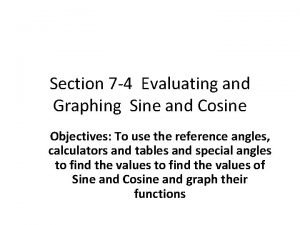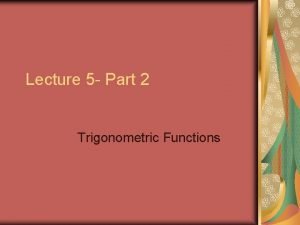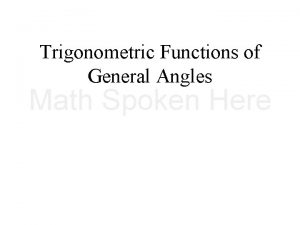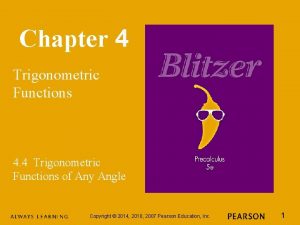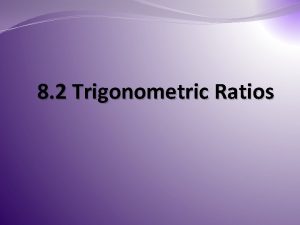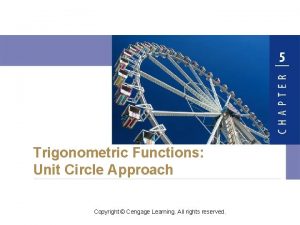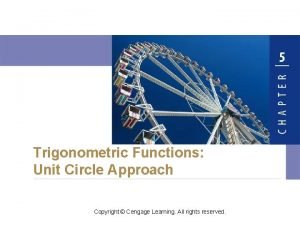5 Trigonometric Functions Copyright Cengage Learning All rights



































- Slides: 35

5 Trigonometric Functions Copyright © Cengage Learning. All rights reserved.

5. 4 Graphs of Sine and Cosine Functions Copyright © Cengage Learning. All rights reserved.

What You Should Learn • Sketch the graphs of basic sine and cosine functions • Use amplitude and period to help sketch the graphs of sine and cosine functions • Sketch translations of graphs of sine and cosine functions • Use sine and cosine functions to model real-life data 3

Basic Sine and Cosine Curves 4

Basic Sine and Cosine Curves The graph of the sine function is a sine curve. In Figure 5. 42, the black portion of the graph represents one period of the function and is called one cycle of the sine curve. Figure 5. 42 The gray portion of the graph indicates that the basic sine wave repeats indefinitely to the right and left. 5

Basic Sine and Cosine Curves The graph of the cosine function is shown in Figure 5. 43 6

Basic Sine and Cosine Curves The domain of the sine and cosine functions is the set of all real numbers. The range of each function is the interval [– 1, 1] and each function has a period 2. 7

Basic Sine and Cosine Curves Do you see how this information is consistent with the basic graphs shown in Figures 5. 42 and 5. 43? Figure 5. 42 Figure 5. 43 8

Basic Sine and Cosine Curves To sketch the graphs of the basic sine and cosine functions by hand, it helps to note five key points in one period of each graph: the intercepts, the maximum points, and the minimum points. The table below lists the five key points on the graphs of y = sin x and y = cos x. 9

Basic Sine and Cosine Curves Note in Figures 5. 42 and 5. 43 that the sine curve is symmetric with respect to the origin, whereas the cosine curve is symmetric with respect to the y-axis. These properties of symmetry follow from the fact that the sine function is odd whereas the cosine function is even. Figure 5. 42 Figure 5. 43 10

Basic Sine and Cosine Curves The basic characteristics of the parent sine function and parent cosine function are listed below 11

Example 1 – Library of Parent Functions: f (x) = sin x Sketch the graph of g (x) = 2 sin x by hand on the interval [– , 4 ]. Solution: Note that g (x) = 2 sin x = 2(sin x) indicates that the y-values of the key points will have twice the magnitude of those on the graph of f (x) = sin x. Divide the period 2 into four equal parts to get the key points 12

Example 1 – Solution cont’d By connecting these key points with a smooth curve and extending the curve in both directions over the interval [– , 4 ], you obtain the graph shown in Figure 5. 44 13

Amplitude and Period of Sine and Cosine Curves 14

Amplitude and Period of Sine and Cosine Curves Let us discuss the graphic effect of each of the constants a, b, c, and d in equations of the forms y = d + a sin(bx – c) and y = d + a cos(bx – c). The constant factor a in y = a sin x acts as a scaling factor —a vertical stretch or vertical shrink of the basic sine curve. When | a | > 1, the basic sine curve is stretched, and when | a | < 1, the basic sine curve is shrunk. 15

Amplitude and Period of Sine and Cosine Curves The result is that the graph of y = a sin x ranges between –a and a instead of between – 1 and 1. The absolute value of a is the amplitude of the function y = a sin x. The range of the function y = a sin x for a > 0 is –a y a. 16

Example 2 – Scaling: Vertical Shrinking and Stretching On the same set of coordinate axes, sketch the graph of each function by hand. a. b. y = 3 cos x Solution: a. Because the amplitude of is , the maximum value is and the minimum value is –. Divide one cycle, 0 x 2 , into four equal parts to get the key points 17

Example 2 – Solution cont’d b. A similar analysis shows that the amplitude of y = 3 cos x is 3, and the key points are 18

Example 2 – Solution cont’d The graphs of these two functions are shown in Figure 5. 45. Notice that the graph of is a vertical shrink of the graph of y = cos x and the graph of Figure 5. 45 y = 3 cos x is a vertical stretch of the graph of y = cos x. 19

Amplitude and Period of Sine and Cosine Curves The graph of y = –f (x) is a reflection in the x-axis of the graph of y = f (x). For instance, the graph of y = – 3 cos x is a reflection of the graph of y = 3 cos x, as shown in Figure 5. 46 20

Amplitude and Period of Sine and Cosine Curves Next, consider the effect of the positive real number b on the graphs of y = a sin bx and y = a cos bx. Because y = a sin x completes one cycle from x = 0 to x = 2 , it follows that y = a sin bx completes one cycle from x = 0 to x = 2 b. 21

Amplitude and Period of Sine and Cosine Curves Note that when 0 < b < 1, the period of y = a sin bx is greater than 2 and represents a horizontal stretching of the graph of y = a sin x. Similarly, when b > 1, the period of y = a sin bx is less than 2 and represents a horizontal shrinking of the graph of y = a sin x. When b is negative, the identities sin(–x) = –sin x and cos(–x) = cos x are used to rewrite the function. 22

Translations of Sine and Cosine Curves 23

Translations of Sine and Cosine Curves The constant c in the general equations y = a sin(bx – c) and y = a cos(bx – c) creates horizontal translations (shifts) of the basic sine and cosine curves. Comparing y = a sin bx with y = a sin(bx – c), you find that the graph of y = a sin(bx – c) completes one cycle from bx – c = 0 to bx – c = 2. By solving for x, you can find the interval for one cycle to be 24

Translations of Sine and Cosine Curves This implies that the period of y = a sin(bx – c) is 2 b, and the graph of y = a sin bx is shifted by an amount c b. The number c b is the phase shift. 25

Example 4 – Horizontal Translation Analyze the graph of Solution: The amplitude is equations and the period is 2. By solving the you see that the interval corresponds to one cycle of the graph. 26

Example 4 – Solution cont’d Dividing this interval into four equal parts produces the following key points. 27

Mathematical Modeling 28

Mathematical Modeling Sine and cosine functions can be used to model many real-life situations, including electric currents, musical tones, radio waves, tides, and weather patterns. 29

Example 8 – Finding a Trigonometric Model Throughout the day, the depth of the water at the end of a dock varies with the tides. The table shows the depths (in feet) at various times during the morning. 30

Example 8 – Finding a Trigonometric Model cont’d a. Use a trigonometric function to model the data. Let t be the time, with t = 0 corresponding to midnight. b. A boat needs at least 10 feet of water to moor at the dock. During what times in the evening can it safely dock? Solution: a. Begin by graphing the data, as shown in Figure 5. 52. You can use either a sine or cosine model. Suppose you use a cosine model of the form y = a cos(bt – c) + d. Figure 5. 52 31

Example 8 – Solution cont’d The difference between the maximum height and minimum height of the graph is twice the amplitude of the function. So, the amplitude is a= = [(maximum depth) – (minimum depth)] (11. 3 – 0. 1) = 5. 6. 32

Example 8 – Solution cont’d The cosine function completes one half of a cycle between the times at which the maximum and minimum depths occur. So, the period p is p = 2[(time of min. depth) – (time of max. depth)] = 2(10 – 4) = 12 which implies that b = 2 p 0. 524. 33

Example 8 – Solution cont’d Because high tide occurs 4 hours after midnight, consider the left endpoint to be c b = 4, so c 2. 094. Moreover, because the average depth is (11. 3 + 0. 1) = 5. 7 it follows that d = 5. 7. So, you can model the depth with the function y = 5. 6 cos(0. 524 t – 2. 094) + 5. 7. 34

Example 8 – Solution cont’d b. Using a graphing utility, graph the model with the line y = 10. Using the intersect feature, you can determine that the depth is at least 10 feet between 2: 42 P. M. (t 14. 7) and 5: 18 P. M. (t 17. 3), as shown in Figure 5. 53 35
 Cengage chapter 7
Cengage chapter 7 Copyright 2015 all rights reserved
Copyright 2015 all rights reserved Copyright 2015 all rights reserved
Copyright 2015 all rights reserved Dell all rights reserved copyright 2009
Dell all rights reserved copyright 2009 Copyright © 2018 all rights reserved
Copyright © 2018 all rights reserved Trigonometry graph
Trigonometry graph Arcsin table
Arcsin table Delmar cengage learning medical terminology
Delmar cengage learning medical terminology Cengage learning heart diagram
Cengage learning heart diagram Cengage learning heart diagram
Cengage learning heart diagram South-western cengage learning
South-western cengage learning Chapter 13 medical math
Chapter 13 medical math 2009 delmar cengage learning
2009 delmar cengage learning Cengage learning heart diagram
Cengage learning heart diagram Challenge word building medical terminology
Challenge word building medical terminology Cengage learning australia
Cengage learning australia 2009 delmar cengage learning
2009 delmar cengage learning Whille
Whille Cengage learning
Cengage learning Wadsworth cengage learning
Wadsworth cengage learning Cengage learning
Cengage learning Cengage learning plant cell
Cengage learning plant cell Cengage learning
Cengage learning Cengage learning
Cengage learning Brooks cole cengage learning
Brooks cole cengage learning Cengage learning chapter 7 answers
Cengage learning chapter 7 answers 2014 cengage learning accounting answers
2014 cengage learning accounting answers Cengage learning
Cengage learning Cengage learning
Cengage learning Chapter 6 the skeletal system answer key
Chapter 6 the skeletal system answer key Cengage learning
Cengage learning Chapter 10 cultural diversity
Chapter 10 cultural diversity Consumer behavior cengage
Consumer behavior cengage 2012 cengage learning
2012 cengage learning Cengage learning 2013
Cengage learning 2013 Cengage learning psychology
Cengage learning psychology





